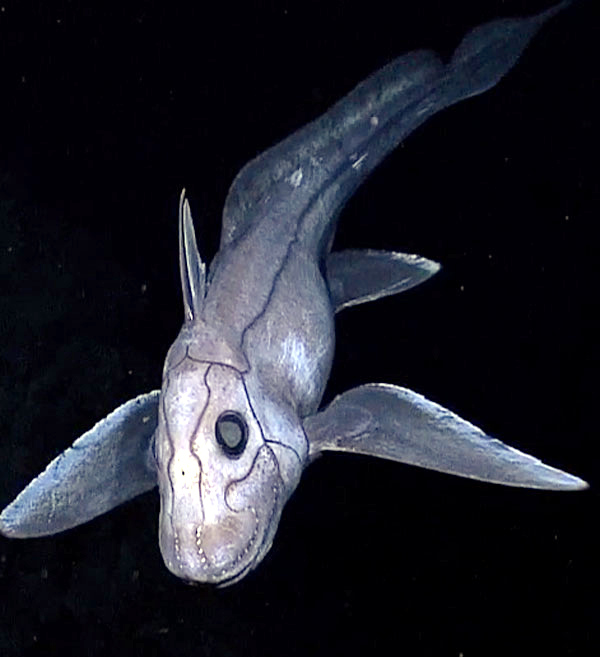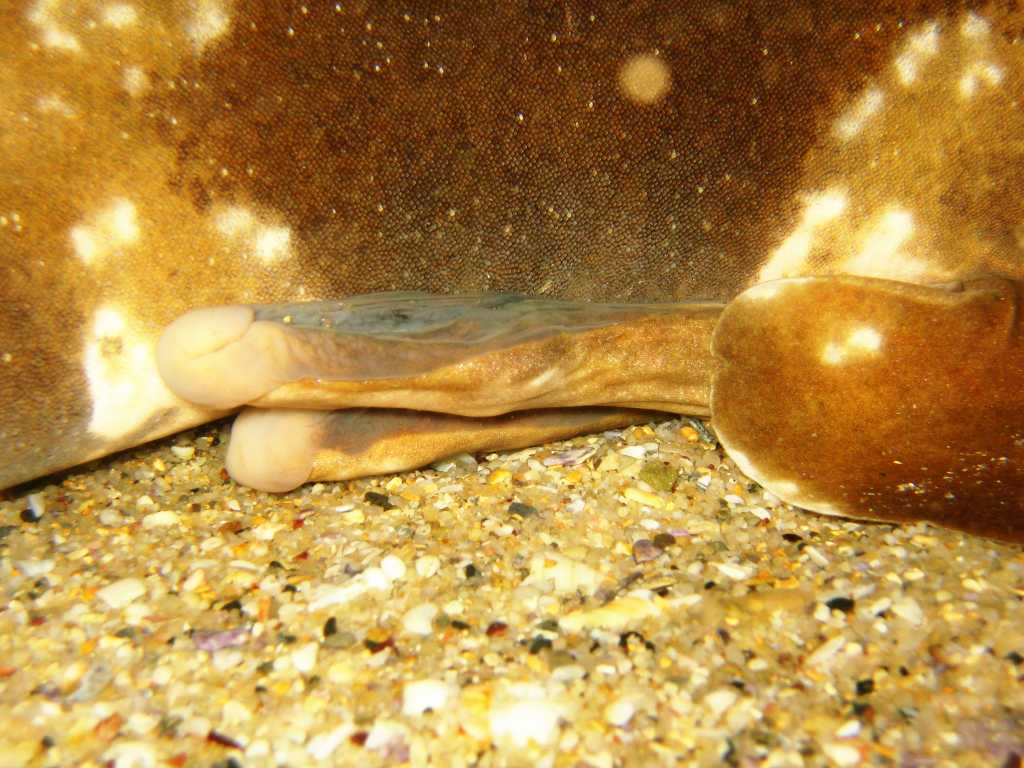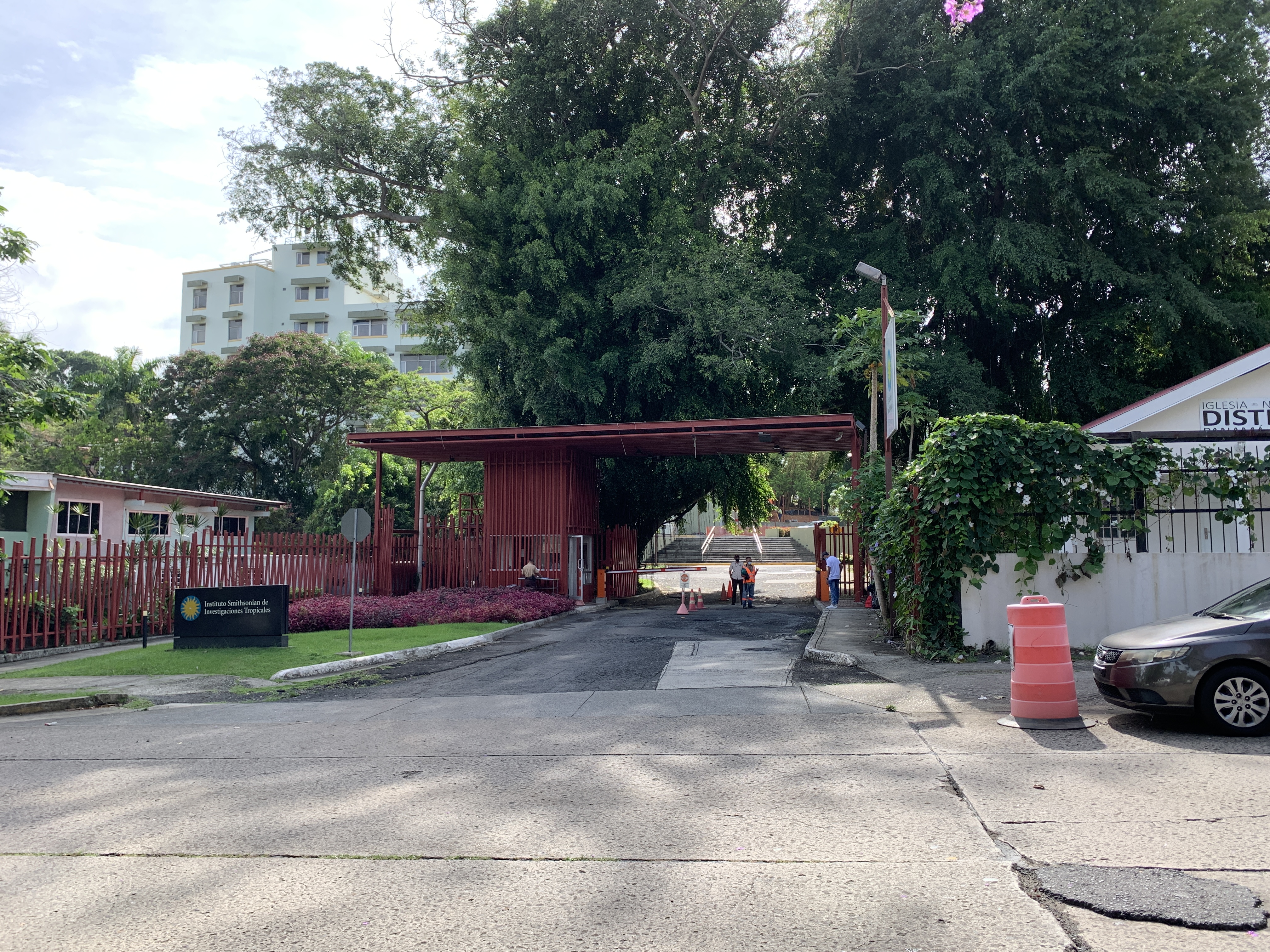|
Hydrolagus Alphus
The whitespot ghost shark (''Hydrolagus alphus'') is a chimaera species in the family Chimaeridae, which lives in parts of the Galápagos Islands in the southeast Pacific Ocean. It lives in waters with steep slopes and boulders and grows to a total length of around . Discovery The whitespot ghost shark was first described in 2006 by Kimberly Quaranta, Dominique Didier, Douglas Long, and David Ebert in ''Zootaxa''. The specific name, ''alphus'', is Latin and refers to the white spot on its skin. Because the species' habitat is too rough for trawls to operate in, the species has only been discovered using submersibles. Description According to the International Union for Conservation of Nature (IUCN), of the two specimens that were caught and examined, one, a female, had a body length of and a total length of , and the other, a male, had a body length of and a total length of . The male examined was an adult, while the female was not fully grown yet. The chimaera has a single ... [...More Info...] [...Related Items...] OR: [Wikipedia] [Google] [Baidu] |
Chimaera
Chimaeras are cartilaginous fish in the order Chimaeriformes , known informally as ghost sharks, rat fish, spookfish, or rabbit fish; the last three names are not to be confused with rattails, Opisthoproctidae, or Siganidae, respectively. At one time a "diverse and abundant" group (based on the fossil record), their closest living relatives are sharks and rays, though their last common ancestor with them lived nearly 400 million years ago. Today, they are largely confined to deep water. Description and habits Chimaeras live in temperate ocean floors down to deep, with few occurring at depths shallower than . Exceptions include the members of the genus ''Callorhinchus'', the rabbit fish and the spotted ratfish, which locally or periodically can be found at shallower depths. Consequently, these are also among the few species from the chimaera order kept in public aquaria. They live in all the oceans except for the Arctic and Antarctic oceans. They have elongated, soft ... [...More Info...] [...Related Items...] OR: [Wikipedia] [Google] [Baidu] |
Benthopelagic
The demersal zone is the part of the sea or ocean (or deep lake) consisting of the part of the water column near to (and significantly affected by) the seabed and the benthos. The demersal zone is just above the benthic zone and forms a layer of the larger profundal zone. Being just above the ocean floor, the demersal zone is variable in depth and can be part of the photic zone where light can penetrate, and photosynthetic organisms grow, or the aphotic zone, which begins between depths of roughly and extends to the ocean depths, where no light penetrates. Fish The distinction between demersal species of fish and pelagic species is not always clear cut. The Atlantic cod (''Gadus morhua'') is a typical demersal fish, but can also be found in the open water column, and the Atlantic herring (''Clupea harengus'') is predominantly a pelagic species but forms large aggregations near the seabed when it spawns on banks of gravel. Two types of fish inhabit the demersal zone: those ... [...More Info...] [...Related Items...] OR: [Wikipedia] [Google] [Baidu] |
Endemic Fauna Of The Galápagos Islands
Endemism is the state of a species being found in a single defined geographic location, such as an island, state, nation, country or other defined zone; organisms that are indigenous to a place are not endemic to it if they are also found elsewhere. For example, the Cape sugarbird is found exclusively in southwestern South Africa and is therefore said to be ''endemic'' to that particular part of the world. An endemic species can be also be referred to as an ''endemism'' or in scientific literature as an ''endemite''. For example '' Cytisus aeolicus'' is an endemite of the Italian flora. '' Adzharia renschi'' was once believed to be an endemite of the Caucasus, but it was later discovered to be a non-indigenous species from South America belonging to a different genus. The extreme opposite of an endemic species is one with a cosmopolitan distribution, having a global or widespread range. A rare alternative term for a species that is endemic is "precinctive", which applies to ... [...More Info...] [...Related Items...] OR: [Wikipedia] [Google] [Baidu] |
Hydrolagus
''Hydrolagus'' is a genus of fish in the family Chimaeridae found in the Atlantic, Indian and Pacific Oceans.Weigmann, S. (2016)Annotated checklist of the living sharks, batoids and chimaeras (Chondrichthyes) of the world, with a focus on biogeographical diversity.''Journal of Fish Biology, 88 (3): 837-1037.'' Species The 23 recognized species in this genus are: * '' Hydrolagus affinis'' ( Brito Capello ( pt), 1868) (small-eyed rabbitfish) * '' Hydrolagus africanus'' ( Gilchrist, 1922) (African chimaera) Walovich, K.A., Ebert, D.A., Long, D.J. & Didier, D.A. (2015)Redescription of ''Hydrolagus africanus'' (Gilchrist, 1922) (Chimaeriformes: Chimaeridae), with a review of southern African chimaeroids and a key to their identification.''African Journal of Marine Science, 37 (2): 157-165.'' * ''Hydrolagus alberti'' Bigelow & Schroeder, 1951 (gulf chimaera) * ''Hydrolagus alphus'' Quaranta, Didier, Long & Ebert, 2006 (whitespot ghost shark) * '' Hydrolagus barbouri'' (Garman, 1908) ... [...More Info...] [...Related Items...] OR: [Wikipedia] [Google] [Baidu] |
Artisanal Fishing
Artisanal fishing (or traditional/subsistence fishing) consists of various small-scale, low-technology, low-capital, fishing practices undertaken by individual fishing households (as opposed to commercial fishing). Many of these households are of coastal or island ethnic groups. These households make short (rarely overnight) fishing trips close to the shore. Their produce is usually not processed and is mainly for local consumption. Artisan fishing uses traditional fishing techniques such as rod and tackle, fishing arrows and harpoons, cast nets, and small (if any) traditional fishing boats. For that reason, socio-economic status of artisanal fishing community has become an interest of the authorities in recent years. Artisan fishing may be undertaken for both commercial and subsistence reasons. It contrasts with large-scale modern commercial fishing practices in that it is often less wasteful and less stressful on fish populations than modern industrial fishing. Target 14.b ... [...More Info...] [...Related Items...] OR: [Wikipedia] [Google] [Baidu] |
Galápagos Marine Reserve
The Galápagos Marine Reserve (GMR) lies a thousand kilometres from the Ecuadorian mainland and covers an area of around . The Galápagos Islands and the surrounding waters represent one of the world’s most unusual ecosystems and are rich areas of biodiversity. Recently granted UNESCO World Heritage Site status, the Galápagos Marine Reserve is the largest marine reserve in a developing country and the second largest reserve in the world. Snorkeling and diving In certain areas in the Galápagos Marine Reserve, it is possible for visitors to dive or snorkel, and many guests have come into contact with diverse aquatic species which live underwater: Whales, whale sharks, hammerhead sharks, rays, manta rays, swordfish and sea turtles, etc. Other habitats within the GMR are the rocky seabed, vertical rock faces, sandy beaches, mangrove swamps and, to a lesser extent, coral reefs. A popular spot is Tortuga Bay on the Island of Santa Cruz where there is a separate mangrove where ther ... [...More Info...] [...Related Items...] OR: [Wikipedia] [Google] [Baidu] |
Endemic
Endemism is the state of a species being found in a single defined geographic location, such as an island, state, nation, country or other defined zone; organisms that are indigenous to a place are not endemic to it if they are also found elsewhere. For example, the Cape sugarbird is found exclusively in southwestern South Africa and is therefore said to be ''endemic'' to that particular part of the world. An endemic species can be also be referred to as an ''endemism'' or in scientific literature as an ''endemite''. For example '' Cytisus aeolicus'' is an endemite of the Italian flora. '' Adzharia renschi'' was once believed to be an endemite of the Caucasus, but it was later discovered to be a non-indigenous species from South America belonging to a different genus. The extreme opposite of an endemic species is one with a cosmopolitan distribution, having a global or widespread range. A rare alternative term for a species that is endemic is "precinctive", which applies to ... [...More Info...] [...Related Items...] OR: [Wikipedia] [Google] [Baidu] |
Hydrolagus Mccoskeri
''Hydrolagus'' is a genus of fish in the family Chimaeridae found in the Atlantic, Indian and Pacific Oceans.Weigmann, S. (2016)Annotated checklist of the living sharks, batoids and chimaeras (Chondrichthyes) of the world, with a focus on biogeographical diversity.''Journal of Fish Biology, 88 (3): 837-1037.'' Species The 23 recognized species in this genus are: * '' Hydrolagus affinis'' ( Brito Capello ( pt), 1868) (small-eyed rabbitfish) * '' Hydrolagus africanus'' ( Gilchrist, 1922) (African chimaera) Walovich, K.A., Ebert, D.A., Long, D.J. & Didier, D.A. (2015)Redescription of ''Hydrolagus africanus'' (Gilchrist, 1922) (Chimaeriformes: Chimaeridae), with a review of southern African chimaeroids and a key to their identification.''African Journal of Marine Science, 37 (2): 157-165.'' * ''Hydrolagus alberti'' Bigelow & Schroeder, 1951 (gulf chimaera) * ''Hydrolagus alphus'' Quaranta, Didier, Long & Ebert, 2006 (whitespot ghost shark) * '' Hydrolagus barbouri'' (Garman, 1908) ... [...More Info...] [...Related Items...] OR: [Wikipedia] [Google] [Baidu] |
Bathyal Zone
The bathypelagic zone or bathyal zone (from Greek βαθύς (bathýs), deep) is the part of the open ocean that extends from a depth of below the ocean surface. It lies between the mesopelagic above, and the abyssopelagic below. The bathypelagic is known as the midnight zone because of the lack of sunlight; this feature does not allow for photosynthesis-driven primary production, preventing growth of phytoplankton or aquatic plants. Although larger by volume than the photic zone, our knowledge of the bathypelagic zone remains limited by our ability to explore the deep ocean. Physical characteristics The bathypelagic zone is characterized by a nearly constant temperature of approximately and a salinity range of 33-35 g/kg. This region has little to no light, because sunlight does not reach this deep in the ocean and bioluminescence is limited. The hydrostatic pressure in this zone ranges 100-400 atmospheres (atm), due to the increase of 1 atm for every 10 m depth. It is bel ... [...More Info...] [...Related Items...] OR: [Wikipedia] [Google] [Baidu] |
Claspers
In biology, a clasper is a male anatomical structure found in some groups of animals, used in mating. Male cartilaginous fish have claspers formed from the posterior portion of their pelvic fin which serve to channel semen into the female's cloaca during mating. The act of mating in some fish including sharks usually includes one of the claspers raised to allow water into the siphon through a specific orifice. The clasper is then inserted into the cloaca, where it opens like an umbrella to anchor its position. The siphon then begins to contract, expelling water and sperm. The claspers of many shark species have spines or hooks, which may hold them in place during copulation. Male chimaeras have cephalic claspers (tenacula) on their heads, which are thought to aid in holding the female during mating. In entomology, it is a structure in male insects that is used to hold the female during copulation (see Lepidoptera genitalia for more). See also *Sexual coercion among animal ... [...More Info...] [...Related Items...] OR: [Wikipedia] [Google] [Baidu] |
Chimaeridae
The Chimaeridae, or short-nosed chimaeras, are a family of cartilaginous fish. They resemble other chimaeras in general form and habits, but have short, rounded snouts, without the modifications found in related families. Many species have long, tapering tails, giving them an alternative name of ratfish. Shortnose chimaeras have a venomous spine on their backs, which is sufficiently dangerous to injure humans. They are found in temperate and tropical marine waters worldwide. Most species are restricted to depths below , but a few, notably the spotted ratfish and rabbit fish, can locally be found at relatively shallow depths. They range from in maximum total length, depending on species. Species The species are grouped into two genera and include: Family Chimaeridae * Genus ''Chimaera'' Linnaeus, 1758 ** '' Chimaera argiloba'' Last, W. T. White & Pogonoski, 2008 (whitefin chimaera) ** '' Chimaera bahamaensis'' Kemper, Ebert, Didier & Compagno, 2010 (Bahamas ghostshark ... [...More Info...] [...Related Items...] OR: [Wikipedia] [Google] [Baidu] |
Smithsonian Tropical Research Institute
The Smithsonian Tropical Research Institute (STRI, es, Instituto Smithsonian de Investigaciones Tropicales) is located in Panama and is the only bureau of the Smithsonian Institution based outside of the United States. It is dedicated to understanding the past, present, and future of tropical ecosystems and their relevance to human welfare. STRI grew out of a small field station established in 1923 on Barro Colorado Island in the Panama Canal Zone to become one of the world's leading tropical research organizations. STRI's facilities provide for long-term ecological studies in the tropics and are used by some 1,200 visiting scientists from academic and research institutions around the world every year. History Smithsonian scientists first came to Panama during the construction of the Panama Canal from 1904 to 1914. The Secretary of the Smithsonian Institution, Charles Doolittle Walcott, reached an agreement with Federico Boyd to conduct a biological inventory of the new Canal Zo ... [...More Info...] [...Related Items...] OR: [Wikipedia] [Google] [Baidu] |


.jpg)



